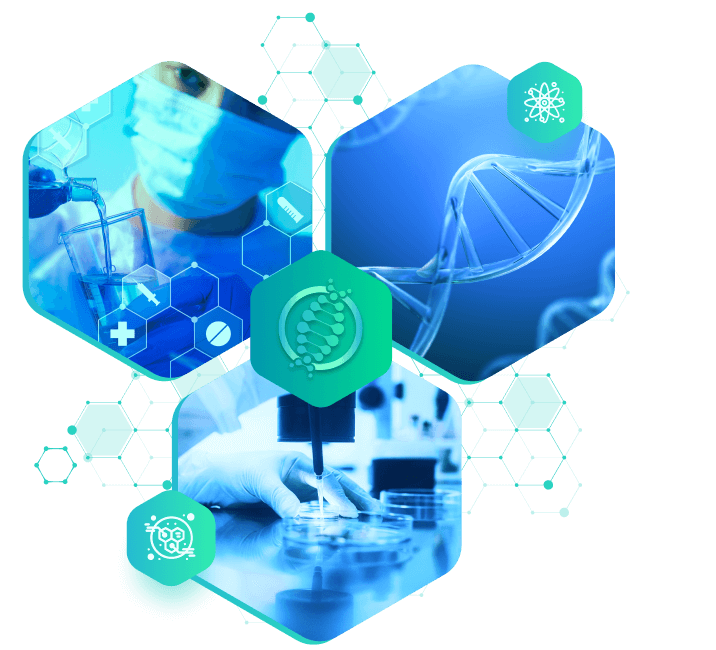
Healing Beauty
With Precision Science

What Is Regenerative Medicine?
Regenerative medicine is a cutting-edge field of medical science focused on repairing, replacing, or regenerating damaged or diseased cells, tissues, and organs to restore normal function. It combines principles from biology, engineering, and medicine to develop innovative therapies, such as stem cell treatments, tissue engineering, and gene editing. The goal of regenerative medicine is not just to treat symptoms but to heal the underlying cause of a condition, potentially offering long-term or even permanent solutions for injuries and chronic illnesses. This approach holds promise for a wide range of uses in the field of cosmetics.

Regenerative Medicine In Cosmetics
Regenerative medicine is increasingly being applied in the field of cosmetics to promote natural skin rejuvenation, improve healing, and reduce signs of aging. Techniques such as stem cell therapy, platelet-rich plasma (PRP) treatments, and growth factor-based products are used to stimulate the body’s own regenerative processes. These methods can enhance collagen production, improve skin texture and elasticity, and accelerate the repair of damaged tissues. In aesthetic procedures, regenerative approaches are often favored for their ability to produce more natural and longer-lasting results compared to traditional cosmetic treatments. As research advances, regenerative cosmetics continue to offer promising alternatives for age-related concerns and skin restoration.
Cosmetic
Procedures
Using
Regenerative
Medicine
Platelet-Rich Plasma (PRP) Facials
Often called the “vampire facial,” this treatment uses a person’s own blood, processed to concentrate the platelets, which are then injected into the skin to stimulate collagen and elastin production for smoother, firmer skin.
Exosome Therapy
Exosomes, tiny vesicles released by stem cells, carry growth factors and signals that promote skin healing and regeneration. They are used in advanced skincare treatments and microneedling procedures to enhance skin texture and tone.
Stem Cell-Based Creams and Serums
Some skincare products contain stem cell extracts (usually plant-derived or ethically sourced human stem cell factors) that aim to support skin regeneration, reduce wrinkles, and improve hydration.
Fat Grafting with Stem Cells
In cosmetic surgery, fat is harvested from one part of the body, enriched with stem cells, and injected into areas like the face or hands to restore volume and promote tissue regeneration.

What Is Regenerative Medicine?
Regenerative medicine is a cutting-edge field of medical science focused on repairing, replacing, or regenerating damaged or diseased cells, tissues, and organs to restore normal function. It combines principles from biology, engineering, and medicine to develop innovative therapies, such as stem cell treatments, tissue engineering, and gene editing. The goal of regenerative medicine is not just to treat symptoms but to heal the underlying cause of a condition, potentially offering long-term or even permanent solutions for injuries and chronic illnesses. This approach holds promise for a wide range of uses in the field of cosmetics.

Regenerative Medicine In Cosmetics
Regenerative medicine is increasingly being applied in the field of cosmetics to promote natural skin rejuvenation, improve healing, and reduce signs of aging. Techniques such as stem cell therapy, platelet-rich plasma (PRP) treatments, and growth factor-based products are used to stimulate the body’s own regenerative processes. These methods can enhance collagen production, improve skin texture and elasticity, and accelerate the repair of damaged tissues. In aesthetic procedures, regenerative approaches are often favored for their ability to produce more natural and longer-lasting results compared to traditional cosmetic treatments. As research advances, regenerative cosmetics continue to offer promising alternatives for age-related concerns and skin restoration.
Cosmetic
Procedures
Using
Regenerative
Medicine
Platelet-Rich Plasma (PRP) Facials
Often called the “vampire facial,” this treatment uses a person’s own blood, processed to concentrate the platelets, which are then injected into the skin to stimulate collagen and elastin production for smoother, firmer skin.
Exosome Therapy
Exosomes, tiny vesicles released by stem cells, carry growth factors and signals that promote skin healing and regeneration. They are used in advanced skincare treatments and microneedling procedures to enhance skin texture and tone.
Stem Cell-Based Creams and Serums
Some skincare products contain stem cell extracts (usually plant-derived or ethically sourced human stem cell factors) that aim to support skin regeneration, reduce wrinkles, and improve hydration.
Fat Grafting with Stem Cells
In cosmetic surgery, fat is harvested from one part of the body, enriched with stem cells, and injected into areas like the face or hands to restore volume and promote tissue regeneration.
At its core, regenerative medicine focuses on repairing or replacing damaged cells, tissues, or organs using methods like stem cells, growth factors, or tissue engineering.
Skin Rejuvenation
-
Stem Cell Therapy: Derived from plants, fat tissue, or bone marrow—these stem cells help regenerate skin by boosting collagen and elastin production.
-
Exosome Therapy: Exosomes (tiny cell messengers) are used to stimulate skin repair and improve texture, tone, and hydration.
-
PRP (Platelet-Rich Plasma): Known as the “vampire facial,” PRP is made from your own blood and injected into the skin to boost healing and reduce wrinkles.
Scar and Acne Treatment
Techniques like PRP or microneedling combined with growth factors promote healing and smoothen skin by stimulating collagen.
Hair Restoration
PRP for Hair Loss: Injecting PRP into the scalp can awaken dormant follicles and improve hair thickness.
Stem Cell Treatments: Experimental approaches use stem cell-derived factors to stimulate new hair growth.
Wound Healing & Pigmentation
Some regenerative techniques help heal wounds faster, lighten hyperpigmentation, and even out skin tone.
Top Benefits of Regenerative Medicine in Cosmetics
- Natural & Long-Lasting Results: Instead of just masking issues, it stimulates the body’s own repair processes, promoting long-term skin and tissue rejuvenation.
- Enhanced Collagen Production: Treatments like PRP, stem cells, and exosomes encourage collagen and elastin regeneration, which improves skin firmness, elasticity, and texture.
- Minimally Invasive: Most procedures are non-surgical (like injections or microneedling), so there’s less downtime, less scarring, and lower risk compared to traditional cosmetic surgery.
- Improved Healing & Recovery: Speeds up tissue repair and reduces inflammation, which means faster recovery from procedures like laser treatments, microneedling, or chemical peels.
- Safe & Biocompatible: Using your own blood or cells (autologous treatments) reduces the risk of allergic reactions or complications.
- Versatile Uses: Effective for skin aging, acne scars, hair loss, pigmentation, and even under-eye dark circles.
- Boosts Skin Hydration & Glow: Regenerative factors can restore skin moisture and vitality, giving you that healthy glow from within.